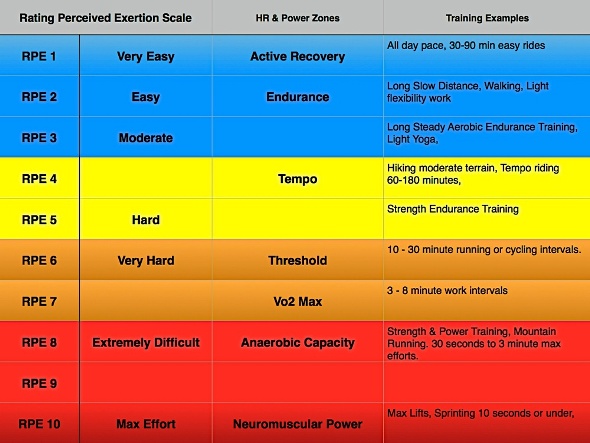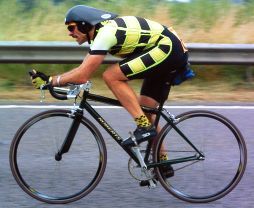Do You Need A Heart Rate Monitor?
About 20 years ago the ultimate piece of training kit was a heart rate monitor. They were used by pro cyclists and other serious sportsmen to monitor their training effort in order to maximise performance gains. However initially they were expensive, but as their popularity grew, so the prices dropped. By about 10 years ago the most basic Polar Heart Rate Monitor had dropped in price to about £50, at which time I bought one. Now a H/R monitor can be bought for as little as £15.
Heart rate monitors were very useful for at last one could “see” how the heart rate increased with effort, and as training became more scientific, we were being informed that to get the best results from our efforts we should train in specific “zones” for specific purposes. For example see the chart below which shows suggested zones matched to age and a percentage of maximum heart rate.
For more detail about zones see anerleybc.org/heart-rate-zones/

There are however some problems with using heart rate numbers to determine the best training intensity. One of course being that we are all individual, and hence different. My maximum heart rate will be different to another male of the same age, and because ladies have a smaller heart than men their max H/R is normally a bit higher. But there are many other reasons why H/R monitors are not perfect and many coaches and other “experts” now suggest that we might be better off using Rating of Perceived Exertion, or R.P.E.
This is very simple to do, and requires no expensive equipment! – You simply ask yourself, how does your effort feel? Is it easy, very hard or somewhere in between? R.P.E can be measured on a simple 1 to 10 scale, the Borg Scale, named after Professor Gunnar Borg who originated it. See below.

Instead of looking at a heart rate monitor just consider your sense of perceived exertion.
What Level of Intensity?
It is generally accepted that maximum aerobic improvement occurs at Lactate Threshold (circa 85% VO2max, approximately 85/90% of your max. heart rate). Being an endurance sport, for most purposes, cyclists can expect to get the greatest overall benefit by training around their lactate threshold (LT). So to use R.P.E just learn to pay attention to your lungs and legs.
- Your lungs. When your breathing is steady and regular, it means you’re at or below your LT. Start to pant, and you’ve gone over your limit and should back off a bit to be at your LT again.
- Your legs. If your quads are just uncomfortable, you are fine. If they start to burn, back off.
It does take a bit of practise and experiment to find the sweet spot, which is just before you start panting. It is hard going at that point, but with determination, possible to ride for long periods at that level – time trialling for example.
Training at L.T is as it says “training”. The chart above indicates that L.T starts at around the transition from R.P.E 5 to 6. Also, that if for example you were training for a sportive or for time trialing, you would benefit from a continuous session of say, 10 to 30 minutes at R.P.E 6. So with the Club’s hill climb competition, time trial, and many sportives on the calendar, you might want to do a bit of training in order to hopefully win one of the Club’s magnificent trophies!

However most of us just want to get a bit fitter and become better hill climbers. Training at LT is ideal for this too, but just do it in shorter bursts. On club rides, our many hills provide ideal opportunities to raise your intensity up to your LT. Your lungs or legs will tell you when to back off a bit before you over do it. Extended sprints to speed limit signs or other markers offer more opportunities for short efforts at lactate threshold. As you get fitter and stronger you can progressively extend the length of time that you continue to ride at the threshold.

One last thing that I should bring your attention, is that the use of heart rate monitors has lead to a misconception that it is our heart that determines our fitness. It appears that it is not the heart, but the legs. One very good reason for us to keep up cycling!
I found this item, which provides a very interesting explanation of why heart rate monitors may not be so beneficial as we have been lead to believe. And it explains why it is the legs that are more important.
Des.



ive never used one des,i always ride on feel,sometimes if I have ridden really hard I will ride easy the next day to get the acid out of my legs,i also believe strecting helps the legs recover from hard training and a good hour dog walk.turbo training once a week improves riders power the most,so if riders want to get faster,this is the way to go.i would say an ideal weeks training should be two long riders a week of two to three hours,and a turbo session of 50 minutes,this should included at least 5 intervals of all out effort of 2 minutes,with a minute easy inbetween,also three 45 second sprints help speed,reving up to 120 plus rev’s per minute.
you haven’t mentioned the full English breakfast Mark!
sorry tom I forgot about my diet tips.